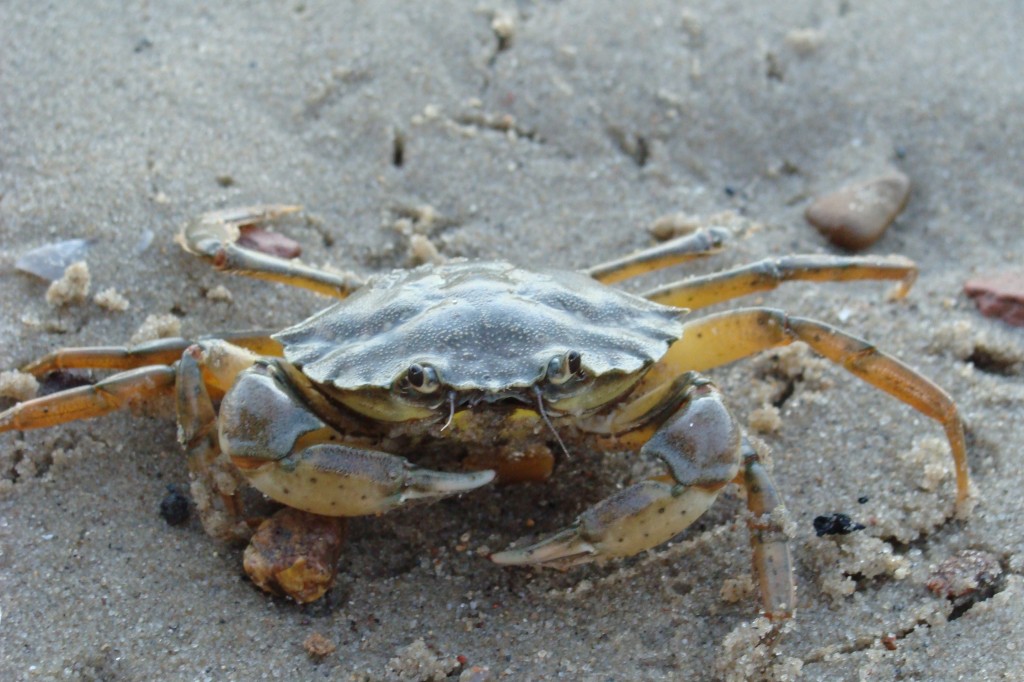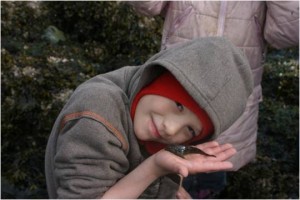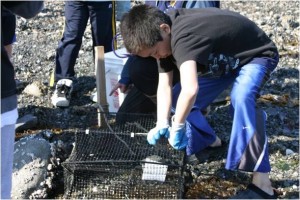by Monaca Noble and Linda McCann
European green crabs are eating and marching their way up the west coast.
One of nine marine invertebrates to make the list of the world’s 100 worst invasive species, they’ve had major economic impacts on shellfisheries in New England, including blue mussels, the Virginia oyster (Crassostrea virginica) and Bay scallops. Impacts are mounting on the west coast too, where losses to bivalve fisheries (Pacific littleneck, Japanese littleneck, softshell clams and blue mussels) are projected to reach $20,000-60,000 per year. Ecologically, their impact has been no less severe, as they prey on and compete with other crabs, bivalves, gastropods like snails and slugs, and many other invertebrates.

European Green Crab Carcinus maenas. Green crabs have visited every continent but Antarctica. They’ve colonized parts of the Americas from Alaska to the southern tip of Argentina. (Arthro)
Green crabs are exceptional world travelers, making it from their native region along the European Coast to six major regions of the world, including the Northwest Atlantic (Maryland to Newfoundland), the Northeast Pacific (California to British Columbia), Patagonia, South Africa, Japan and Australia. Their mode of transport may vary, but evidence suggests they’ve been transported with the live-bait trade and in ships’ ballast water.
Green crabs have been on the East Coast of the US for about 200 years, according the NEMESIS database. They made their first appearance near New Jersey in 1817. From there they moved north, reaching the Bay of Fundy, Nova Scotia in 1953, the Gulf of St. Lawrence by 1994, and finally, Placentia Bay, Newfoundland in 2007. Their southward expansion stopped at the Chesapeake Bay; possibly they couldn’t compete with the blue crab (Callinectes sapidus).
On the West Coast, green crabs were first recorded in 1989 near Bodega Harbor, California, and appeared in San Francisco Bay a year later. Their northward march took them to the north end of Vancouver Island in British Columbia by 2007. By 2011 they were 200 miles from the Alaskan border, the known current extent of their range. Similar to their movement on the East Coast, southward dispersal has been much slower. They reached Morro Bay, their current southern limit, about 200 miles south of San Francisco Bay by 1998.
Concerned about the impact of the green crab invasion on commercial shellfisheries in New England, scientists at the Smithsonian Environmental Research Center (SERC) began a series of lab experiments in 2002 aimed at predicting the future range expansion of the crabs on the West Coast. These experiments tested the ability of the larval crabs (the most fragile life stage) to grow and develop at various temperature and salinity combinations. The idea was that locations on the west coast within the crab’s tolerance limits might be susceptible to an invasion. These experiments suggested that most bays in Southeast Alaska are suitable habitat for green crabs and therefore are at risk of invasion.
Armed with this information and the knowledge that green crabs are advancing northward rapidly, researchers at SERC began training citizens to monitor for green crabs in Alaska. The first citizen-based monitoring effort began in 2004 at the Kachemak Bay Research Reserve. Soon after, sites around Prince William Sound and Southeast, Alaska were added. Monitors include summer cabin residents near the Kachemak Bay Research Reserve, tribal environmental technicians, retired biologists and teachers. In Kachemak Bay, teachers incorporated the monitoring effort into their classrooms, with kids as young as 10 participating in the trapping.
See also: Small lagoon fights off occupation >>
“The monitoring program has been a totally engaging way for students to learn about Kachemak Bay’s intertidal life, invasives, and how scientists track changes in marine life,” said the mother of one young monitor. “The students are able to be actual marine biologists, gathering authentic data. Students also gain an appreciation for their own ‘backyard’ and the need to monitor/protect it.”
And the monitors are doing just that.
Monitors trap throughout the summer months recording their catch for inclusion in a statewide database and serving as an early warning system for green crabs. In an effort to recruit additional volunteer monitors in other parts of Alaska and help existing monitors find information and upload their monitoring data, SERC created the Green Crab Watch website. So far no green crabs have been found, but the traps have held many other wonders. Monitors are learning about native Alaskan crabs and fish, as yet unaffected by invasive species and with any luck, their efforts will keep it that way.



